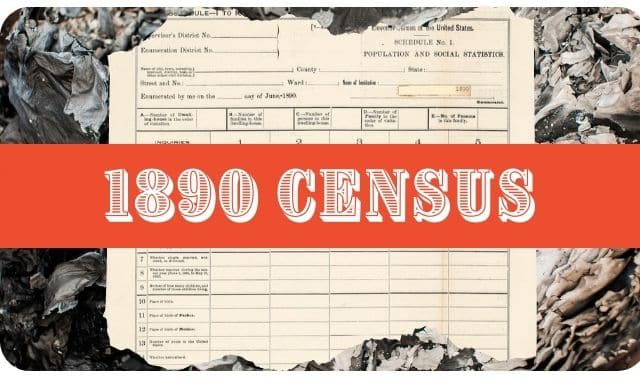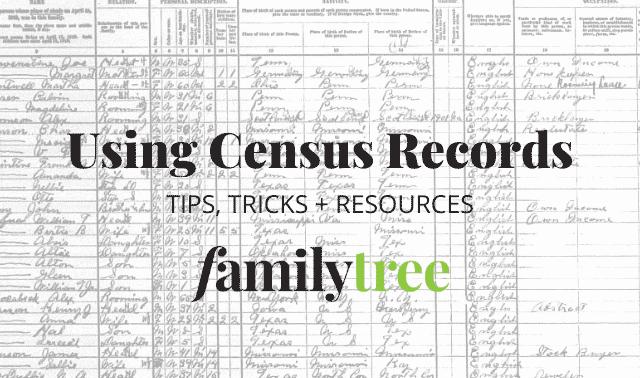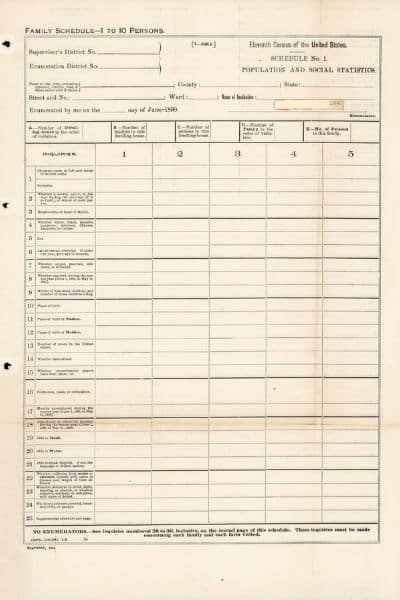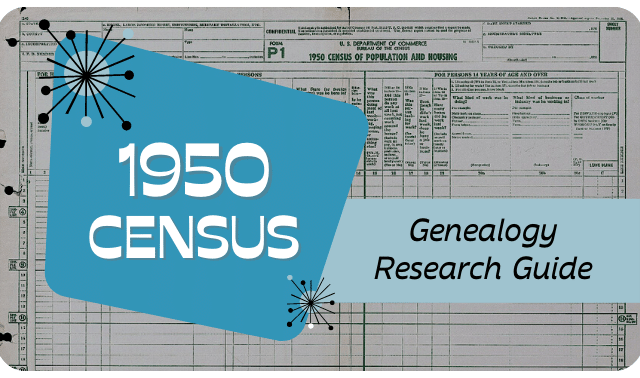Sign up for the Family Tree Newsletter Plus, you’ll receive our 10 Essential Genealogy Research Forms PDF as a special thank you!
Get Your Free Genealogy Forms
"*" indicates required fields
Table of Contents
Lost to fire except for fragments, the 1890 forms adopted a dramatically different, vertical look and added questions about how long a person had lived in the United States and his or her naturalization status. (As in subsequent years, Na is short for naturalized.)
This enumeration also included the column “mother of how many children” and how many of those children were living. The 1890 census included a veterans schedule for enumerating Union veterans of the Civil War (although some Confederates were also counted) and their widows; about half of these schedules survived and can substitute for the lost census if you’re lucky enough to have a Union soldier in the family.
David Fryxell, “US Census Information Year-by-Year for Genealogists“
1890 Census Fast Facts
OFFICIAL
DATE
June 1
NUMBER OF
QUESTIONS
30
NUMBER OF
STATES
42
DECENNIAL
CENSUS NUMBER
11th
NOTABLE
QUESTIONS
Length of time living in US
Naturalization status
# of children
How many children living
Civil War veterans/widows schedule
10 LARGEST CITIES
New York City, NY
Chicago, IL
Philadelphia, PA
Brooklyn, NY
St. Louis, MO
Boston, MA
Baltimore, MA
San Francisco, CA
Cincinnati, OH
Cleveland, OH
What happened to the 1890 census?
The 1890 census is a bit of a sore subject for genealogists. Bringing it up sparks bad dreams, anguished “if only”s and anxieties over everlasting brick walls. Why?
More than 99 percent of the records were destroyed Jan. 10, 1921, in a fire in the basement of the Commerce Building. When the fire broke out, firefighters flooded the basement with water. The flames didn’t spread to upper floors, but the 1890 census records—piled outside a records storage vault—were soaked. (Even some of the census schedules stored inside the supposedly waterproof vault got wet.)
The cause of the blaze couldn’t be determined.
The records sat in storage for awhile, with no restoration efforts made. Rumors circulated that they’d be disposed of; various groups protesting such measures were assured the rumors were unfounded. But sometime between 1933 and 1935, the records were destroyed along with other papers the Census Bureau deemed no longer necessary.
I almost don’t want to tell you how future genealogists almost dodged this bullet: According to a 1996 article in the National Archives’ Prologue magazine (vol. 28, no. 1), all or part of 1790 through 1880 census schedules had to be filed in county clerks’ offices. But this wasn’t required in 1890; all the schedules were forwarded to Washington, DC.
Fragments of the 1890 census bearing 6,160 names later turned up, and are viewable on microfilm. Also surviving are special 1890 schedules for half of Kentucky and states alphabetically following it, which enumerate Union veterans and their widows.
In a precursor to the 1921 tragedy, an 1896 fire badly damaged 1890 special schedules including mortality, crime, pauperism and “special classes.” They were destroyed by Department of the Interior order.
Diane Haddad
1890 Census Form Images
Page 1
Page 2
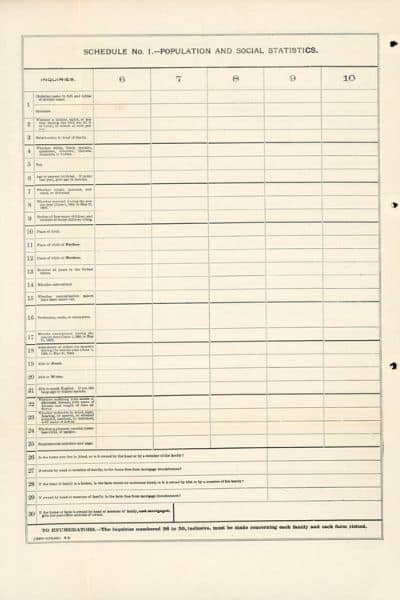
1890 Census Questions
Across the top of the sheet were several organizational questions:
- Number of dwelling house in the order of visitation by enumerator
- Number of families in the dwelling house
- Number of persons in the dwelling house
- Number of this family in order of visitation by enumerator
- Number of persons in this family
The following questions, listed by row number, were asked of each individual resident:
- Christian name in full, and initial of middle name
- Surname
- Was this person a soldier, sailor, or marine during the Civil War (U.S.A. or C.S.A.), or the widow of such a person?
- Relationship to the head of the family
- Race
Enumerators were instructed to write “White,” “Black,” “Mulatto,” “Quadroon,” “Octoroon,” “Chinese,” “Japanese,” or “Indian.”) - Sex
- Age
- Was the person single, married, widowed, or divorced?
- Was the person married within the last year?
- How many children was the person a mother of? How many of those children were living?
- Person’s place of birth
- Place of birth of person’s father
- Place of birth of person’s mother
- How many years has the person been in the United States?
- Is the person naturalized?
- Has the person taken naturalization papers out?
- Profession, trade, or occupation
- Number of months unemployed in the past year
- How many months did the person attend school in the past year?
- Can the person read?
- Can the person write?
- Can the person speak English? If not, what language does he speak?
- Is the person suffering from an acute chronic disease? If so, what is the name of that disease and the length of time affected?
- Is the person defective of mind, sight, hearing, or speech? Is the person crippled, maimed, or deformed? If yes, what was the name of his defect?
- Is the person a prisoner, convict, homeless child, or pauper?
Depending on the person’s status in the questions in rows 22, 23, or 24, the enumerator would indicate on this line whether additional information was recorded about him on a special schedule
The following questions, located at the end of each family’s questionnaire sheet were asked of each family and farm visited: - Was the home the family lived in hired, or was it owned by the head or by a member of the family?
- If owned by a member of the family, was the home free from “mortgage incumbrance?”
- If the head of the family was a farmer, was the farm which he cultivated hired or was it owned by him or a member of his family?
- If owned by the head or member of the family, was the farm free from “mortgage incumbrance?”
- If the home or farm was owned by the head or member of the family, and mortgaged, what was the post office address of the owner?
United States Census Bureau, Index of Questions: 1890
Where can I find the 1890 census (or substitutes)?
Alternatives to the 1890 Census
One of the most famous cases of burned genealogical records is the 1890 US census. Here are tips for working with (and around) these lost records:
The 1890 census included detailed population schedules and special schedules for Union veterans and widows, mortality, crime, pauperism and benevolence, the disabled, insurance and transportation. All were almost entirely destroyed after being damaged in two separate fires: one in 1896 that affected the special schedules, and another in 1921, which claimed the population schedules. No copies had been made for county clerks, as had been the practice for previous censuses.
- Surviving records: fragments of populations schedules containing 6,160 names from Alabama, Georgia, Illinois, Minnesota, New Jersey, New York, North Carolina, Ohio, South Dakota, Texas and Washington, DC; Union veterans and widows schedules for half of Kentucky and states alphabetically following it (some are incomplete), Oklahoma and Indian Territories; and a few miscellaneous schedules for other states.
- Availability: Population schedules are on National Archives microfilm publication M407; veterans schedules are on microfilm M123. Online, Ancestry.com’s 1890 Census Substitute database has surviving schedules and several substitute record series, including many of those listed below.
- Substitutes: tax lists; city directories; voter registrations; state censuses; an 1885 federal census for Colorado, Florida, Nebraska, New Mexico, North Dakota and South Dakota; 1890 Oklahoma territorial census; 1890 poll lists for parts of Arizona and California.
Sunny Jane Morton
A version of this article appeared in the October/November 2013 issue of Family Tree Magazine.
1890 Census Research Resources
Websites
Census.gov
1890 Fast Facts
1890 Overview
1890 Index of Questions
Cyndi’s List
United States » U.S. Census » 1890 U.S. Federal Census — 1 June 1890
FamilySearch Wiki
United States Census 1890
RootsWeb
1890 U.S. Census
Books
Substitutes for the Lost 1890 U.S. Federal Census by William W. Dollarhide
FamilyTreeMagazine.com is a participant in the Amazon Associates Program, an affiliate advertising program. It provides a means for this site to earn advertising fees, by advertising and linking to Amazon and affiliated websites.
ADVERTISEMENT

